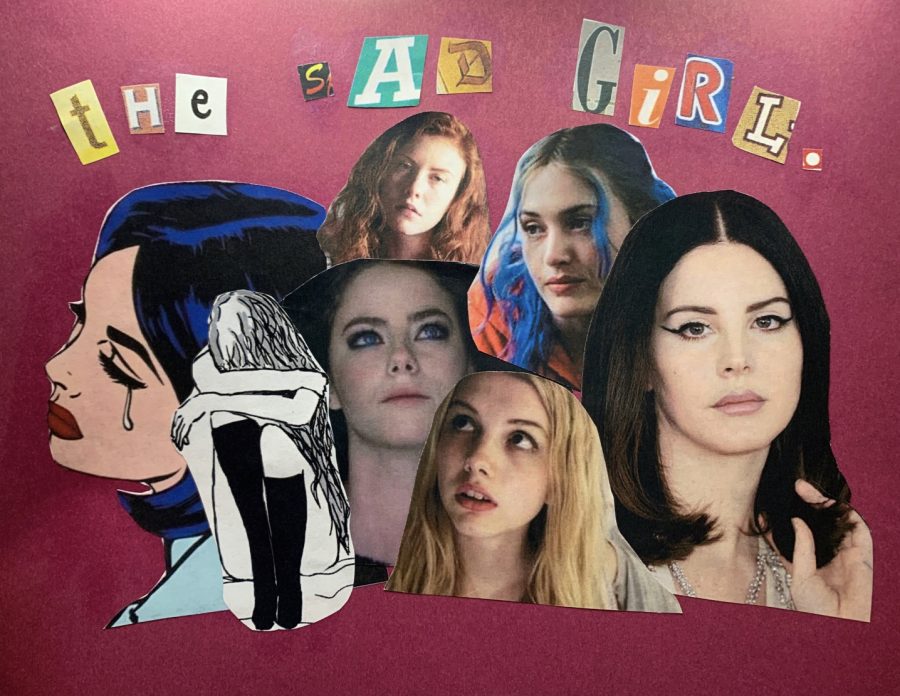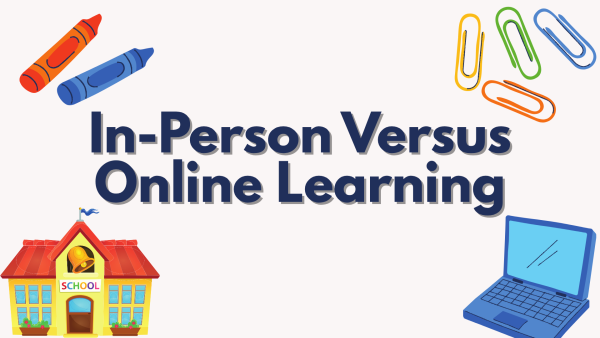Society’s Obsession with the “Sad White Girl”
“The Sad Girl: Notable Figures” original collage by Sarah Hart.
TW: Talk of self-harm, eating disorders, depression, and suicide.
Introduction — Or How We Arrived At This Juncture…
“Let this be clear, I’m not a feminist,” said Lana Del Rey in an Instagram post in May 2020, a few months into the first period of COVID- 19 restrictions in the United States. “But there has to be a place in feminism for women who look and act like me — the kind of woman who says no but men hear yes — the kind of women who are slated mercilessly for being their authentic, delicate selves, the kind of women who get their own stories and voices taken away from them by stronger women or by men who hate women.”
Del Rey goes on to name other popular female music artists including Doja Cat, Kehlani, Beyonce, Nicki Minaj, Ariana Grande, Cardi B, and Camila Cabello, describing the content of their music as solely about “being sexy, wearing no clothes…cheating, etc.”
While this (in Lana’s words) “‘controversial post’ that’s not controversial at all” (notably, she has since deleted her Instagram account) is fairly old news at this point, I recently watched a Youtube video titled “Lana Del Rey: The Pitfalls of Having a Persona” by content creator Mina Le. Ultimately, the video follows Del Rey on a deep dive into her career, discusses the negative example that she has set for young and impressionable girls over her decade of activity, and the controversy she has encountered as a female artist who writes about being submissive, objectified, and, most notably, “glamorizing abuse.”
Not only that, but Lana Del Rey has contributed to the 21st-century cultural phenomenon of the Sad Girl, which over the years has branched out into a plethora of subcultures in media, art, and of course online. If you have ever consumed contemporary media, you have seen the Sad Girl. Formerly known as the damsel in distress, the grieving widow, and the traumatized heroine, the Sad Girl can simply be defined as a girl who is defined by her feminine trauma, heartbreak, and overall gloomy, grounded demeanor. According to Mina Le, “society’s obsession with the Sad White Woman” is a culture within itself, making the Sad Girl a mainstream and well-known figure. Not only that, but the Sad Girl has proven to have impacted the way modern culture operates and contributes to the patriarchy more than we give her credit for.
Exhibit A: Lana Del Rey
In 2012, Lana Del Rey debuted her album that would place her into the mainstream charts and influence a generation of young women: Born to Die. The album was and is often critiqued to romanticize the hyper-feminine stance of needing to find yourself in someone else, to be delicate and overly vulnerable, and to elude stereotypically feminist endeavors in favor of allowing yourself to be dominated in a “man’s world.”
Despite the contradiction to what most would consider being a modern and widely accepted feminist viewpoint in Western culture — the idea that with hard work, persistence, and just a smidge of combativeness, women can succeed and be equal to men — Lana Del Rey’s music appeals to a large audience of women.
In Lindsay Zoldaz’s Pitchfork essay, “Pretty When You Cry,” she makes the statement that popular music (she particularly references Katy Perry’s hit song ROAR), feels “like it was drawn up from focus groups and genetically engineered in a laboratory for the sole purpose of EMPOWERING [LISTENERS].”
Whereas in Lana Del Rey’s music, the appeal for women comes from the simple fact that the songs do such a good job at encapsulating the futile nature in which society tells girls to pursue equality, to fight for equal footing in a system that was custom-made to oppress them. For young women, Lana’s music almost feels like saying “screw you” to all of the teachers and parents that have preached perseverance as a cure-all to the subjugation that all women face at some point in their lives.
Lana Del Rey’s music is, ultimately, one of the defining factors of the Internet Sad Girl Era. Looking at the Sad Girl as a generally one-dimensional figment produced by western societal norms, it is pretty clear that Lana Del Rey’s music matches perfectly with the essence of the Sad Girl, who lives to be sad. Still, it would be inaccurate to say that Lana Del Rey’s music is responsible for building up the modern Sad Girl persona; it is more truthful to make the statement that her work perfectly sums up the Sad White Woman doctrine: to be young and beautiful and abused or to sooner die.
Exhibit B: The Sad Girl on the Internet
Black and white photos of roses, tears, and cigarettes hanging from red, full chapped lips. Rosy cheeks and puffy eyes next to images of batteries at 1%. “S(he) be(lie)ve(d).” “He kissed the scars on her skin / He made her whole again.” Crying selfie. Crybaby by Melanie Martinez. Effy and Cassie from Skins. A crying white girl after crying white girl. The Internet Sad Girl Aesthetic.
For those with unrestricted access to the internet in the early 2010s, the Internet Sad Girl manifested most potently on Tumblr, Twitter, and the beginnings of Instagram in the form of blogs and pages dedicated to perpetuating the culture.
While some pages proved to be empowering and provided a space for people, particularly teenage girls, to vent and share their feelings to a void of strangers, the Internet Sad Girl also established a dangerous criterion for those struggling with mental illness to share tips on harmful activities such as self-harm or even suicide.
While sites like Tumblr have now established guidelines and preventive measures to keep their spaces safe and clean, in the early days there was little to no regulation on what a user could post.
For example, the now-deleted account “Depressions and Disorders” was a page run by a teenage girl (who has since made anonymous comments about running her site in an interview with Buzzfeed) which consisted of posts about self-harm habits and tips, planned suicide attempts, eating disorders, and anonymous confessions submitted by the account’s followers. Although the account owner often suggested therapy to her followers, she also included posts that were in support of self-harming techniques (sometimes including photos) and tips on hiding mental illness and self-harm evidence from parents and therapists.
Thousands upon thousands of tweets flooded feeds, talking about how difficult it was to be a teenage girl, which did nothing but enforce the narrative that women are inherently sad, inherently tortured, and inherently upset about not being beautiful. Perhaps it is simply that the Internet amplified the pre-possessed insecurities of teenage girls and young women, or perhaps Lana Del Rey’s music released some chemical through headphones into the brains of impressionable young women. Whatever the case, the Internet Sad Girl is someone who yearns for a relationship, for a man, who cannot keep her mental state intact or be strong in life. She is treated horribly by men yet wants them all the same, waits eagerly for him to text her back, and enforces heteronormativity.
While this is likely not the intention at the forefront of any self-proclaimed Sad Girl’s mind, the movement reeks of the patriarchy and the ever-present male gaze. As the Sad Girl is presented online, she lives to pour all of her essences into a male counterpart, for someone big and strong to sweep her off her feet and solve all her problems because she can not do it herself. It enforces the idea that women are at their very best when they are sad, young, and helpless.
Of course, the Internet Sad Girl only caters to the SadWhite Girl. The sadness and struggles of women of color or the sadness of the impoverished were and still are virtually ignored on social media. To truly be sad on the Internet and be a part of the Internet Sad Girl trope requires a sadness rooted in white privilege. In other words, sadness about not adhering to Western beauty standards, or experiencing discrimination and marginalization in one’s day-to-day life, or not being able to afford healthcare are not facets of the Internet Sad Girl’s woes.
Of course, the Internet Sad Girl is not all-consuming. In the last five or so years, social media has been used as a powerful tool for change. As feminism evolves, people are made aware of the dire situations that concern the world such as COVID-19, the climate crisis, or movements like Stop Asian Hate. Thus, there is a greater sense of intersectionality within who is included in modern feminism.
In 2020 alone, many feminists, primarily white women, were made aware of the injustices that marginalized groups face in the United States alone, particularly within the Black Lives Matter (BLM), which was sensationalized in the media and online. It became trendy to be an activist and to speak out against injustice, while it became stale and tasteless to be ignorant and self-absorbed. More and more women have been realizing that what you look like and how men perceive you are nothing in the face of terrors like racism, the prison-industrial complex, and the impacts of historical imperialism.
“Maybe we have realized that although not being texted back is irritating, it’s pretty small scale in the face of all the awful things we see every day in the news,” says the Establishment article “The Internet Sad Girl Is Over — And That’s A Good Thing.” “Maybe it just fell out of fashion, as internet trends always do. Or maybe it’s the fact that we have become not just depressed at what is happening, but furious too, and we are no longer content to be regarded as passive.”
Exhibit C: The Manic Pixie Dream Girl and Other Figures
During my journey into the depths of the Sad Girl’s corner of the Internet, I found myself among a cacophony of Sad Girl tropes. The Sad White Woman is an entity that goes by many names and faces, some heavily discussed for their prevalence in media and film, and others that have taken shape by the heavy discussion on social media platforms such as Tik Tok.
Of course, there is the giant of the Sad Girl Industry known as the “manic pixie dream girl.” The manic pixie dream girl, or, as I like to call her, the I’m-not-like-other-girls-girl, exists solely to complement the white, “nice guy,” male protagonist. On the surface, she seems to be independent, cool, and fiercely idealistic, and “quirky.” Bonus points if she has colorful hair and skateboards/rollerblades as a primary form of transportation. Think Ramona Flowers from Scott Pilgrim vs. the World, or Clementine Kruczynski from Eternal Sunshine of the Spotless Mind.
Ultimately, the archetype may give the impression of a conventional feminist, someone boyish and who opposes traditional feminine things such as makeup or dresses, but in reality puts down other women in the process of appealing to the male protagonist; furthermore she rarely passes the Bechdel Test.
Under the “I’m-not-like-other-girls” umbrella, we may encounter the following variations of the Sad Girl in media and online: The Sexy Tragic Muse, The Cool Girl, the Pick Me, and the Broken Bird.
The Sexy Tragic Muse, outlined in more detail in an article by Hannah Brooks Olson titled “I Don’t Want To Be The ‘Troubled Girl’ Anymore,” is an evolution from the previously established starving artist character. After observing examples in television and film (Vanessa from Gossip Girl; Mimi from Rent), in retrospect, the Sexy Tragic Muse tends to be a rather stagnant character, but almost always can be seen backing the male protagonist (who is usually an artist himself). She is only capable of pain, both physical and emotional, and adoration for the male lead. Beyond that, however, the Sexy Tragic Muse is a shell of a person.
One of the more important details that distinguish her from other tropes is that the Sexy Tragic Muse does not exist in real life. She is a symptom of poor and overly-formulaic writing and is inorganic.
Next, we arrive on the Broken Bird. Like the Sexy Tragic Muse, she is mostly only seen in bad writing and rarely glimpsed in real life; she is not a real, multi-dimensional person. Even so, she is a harmful trope within media because she feeds into the Manic Pixie Dream Girl umbrella (which, as we have previously established, encompasses harmful female stereotypes that, at their cores, are perpetrators of the patriarchy).
The Broken Bird suffers from an emotionless existence, devoid of any meaningful emotional development. She is usually viewed as beautiful, cool, and unattainable by the main male protagonist. Bonus points if she is an aloof older sister, the sole female lead in an action film, or the snarky young girl. She is defined by a past trauma, which is the only discernible element of character depth she possesses. Her sole purpose in writing is to check the inclusivity box. How can a film or story be sexist when it includes a super badass chick?
The Cool Girl (sometimes called “Bruh Girl”) is unique in that we can observe her in our everyday lives. She describes herself as the following: the Cool Girl is friends with boys and not girls. She dislikes makeup and wearing dresses, and girly television shows or magazines. She likes hanging out with The Guys because she cannot stand the drama that comes with having female friends. She is into non-girly things like beer, football, video games, and meat. She is adamantly anti-feminist.
She flourishes when she puts other women down. While she might seem tough, she ultimately adheres to the male gaze. The Cool Girl is a woman who is pitted against other women for the benefit of the patriarchy to enforce the subversion of women in society. When interacting with a Cool Girl, it is important to remember that she is a product of a patriarchal society, and while those who consider themselves to be feminists likely find the Cool Girl infuriating, it must be recognized that her attitude is to no fault of her own.
Finally, we move to the Pick Me girl. In many ways, the Pick Me is similar to the Cool Girl in that she is fueled by internalized misogyny and that she chronically puts down other women. However, she differs in that she can (though not always) be feminine, boy-crazy, and obnoxiously flirtatious. Pick Mes push away other women in the hopes that it makes them more attractive to the male gaze.
For a time, Pick Me Girls were trending on TikTok — or rather, making fun of Pick Me Girls was trending on TikTok. The trend involves young women, particularly teenage girls, imitating Pick Mes, usually pulling from real-life experiences in high school or college. While the intended tone of the videos usually is satirical or ironic, the videos are received mostly as a form of comedy, via the comments sections.
For the most part, the primary objective of this trend seemed to not necessarily have been to put down Pick Me Girls but to raise awareness against the harmful attitudes of internalized misogyny within women. The main creators of content calling out Pick Mes have been other women, demonstrating that many females are aware of the issue and are aware that the goal of feminism is inclusion, not polarization of other women, even if they have internalized misogyny. While this is important discourse to have, the fact that social media has made the Pick Me trope well known has led to a trend in Pick Me girls making fun of Pick Me Girls (in true Pick-Me fashion), which only continues to serve the purpose of criticizing women rather than to address actual issues with that mindset. Even further, this has resulted in men taking the Pick-Me-on-Pick-Me criticism as an invitation to make fun of the trope, which thus reinforces the patriarchy.
Pick Mes are not as common in writing, however, they are probably the most common trope found in real life. They are one of the more tangible and therefore more the harmful cliche of the four sub-genres. While all tropes discussed here are all conforming to the male gaze, the Pick Me is the most relevant to the 21st century and society as we know it.
Exhibit D: The Sad Girl Theory
Finally, we reach the more optimistic side of the Internet Sad Girl: Sad Girl Theory. Originally a term coined in 2015 by artist and activist Audrey Wollen, Sad Girl Theory offers a new perspective on the sad female, arguing that feminine sadness can be utilized for empowerment and self-fulfillment. Essentially, it states as follows: women being sad on the internet can be taken as a form of activism and protest. Women and girls can share their sorrows and struggles online to destigmatize female sadness, to provide transparency to womanly struggles for body autonomy, and to change the narrative that “female sadness is weakness” to “female sadness is strength.”
This theory has been embraced by so-called “selfie-feminists.” Artists at the forefront, such as Zofia Krawiec and Wollen herself, have posted pictures encapsulating their sadness — images of them crying, feeling empty, and discomfort in being sexualized. All have acted to expose female sadness, regardless of race, with the intention of empowerment and the normalization of feminine sorrow. While the primary medium for selfie-feminism has been Instagram, sites like Twitter or Youtube have seen similar content (see: artist Molly Soda crying on camera, posted in 2012 on Youtube).
How can we connect these ideologies to modern-day feminism? In interviews, Audrey Wollen has reiterated her theory over and over. She argues that Sad Girl Theory destigmatizes female sadness, bringing awareness and a sense of strength to feminine struggles. It serves as a sort of new-wave feminist concept easily disseminated by the emergence of the Internet and social media.
Additionally, she argues that while the idea to teach girls to live as optimistic, self-loving, “girls-can-do-anything-that-boys-can-do” thinkers is rooted in the right place, it is cruel to raise girls to shirk their feelings of angst, sadness, and frustration at the inequalities they have to face. Moreover, feminism itself is something Wollen believes should encompass the acknowledgment that being a girl can be difficult and painful.
Ultimately, the goal of feminism is to be inclusive to all women, something that the community has struggled with since the movement’s conception. While progress has been made since the early 2010s when the toxic ramifications of the Internet Sad Girl Aesthetic were at an all-time high, the harmful tropes that we see in media because of that standard are still very much present, and they affect real girls and women. The Sad Girl is more than poor writing; it is a direct reflection of our culture. It is because the Sad Girl exists that we need feminism more than ever.
Your donation will support the student journalists of Huntington Beach High School. Your contribution will allow us to cover our annual website hosting costs.
Thank you for supporting our program!







